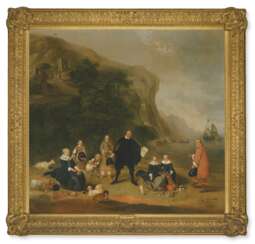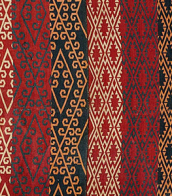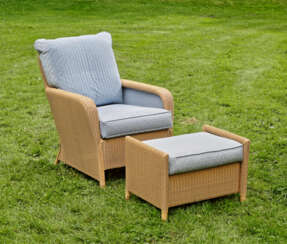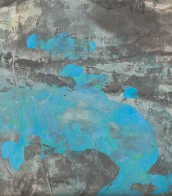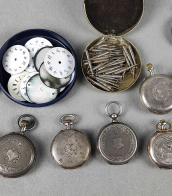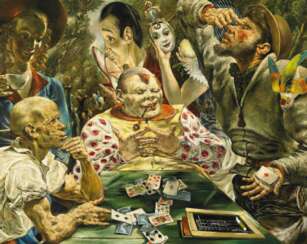artens


Dino Martens was an Italian painter and designer particularly noted for his glass work trained at the Accademia di Belle Arti. He had his paintings exhibited at the Venice Biennale (1924-1930) and after his return from Italy's African wars became the artistic director of Aureliano Toso (the famous Venetian glass works). He remained there for many years producing many noted works using traditional Venetian techniques but producing some original effects, "daring" asymmetric shapes - the designs often being marked by their obvious difficulty of execution.


Dino Martens was an Italian painter and designer particularly noted for his glass work trained at the Accademia di Belle Arti. He had his paintings exhibited at the Venice Biennale (1924-1930) and after his return from Italy's African wars became the artistic director of Aureliano Toso (the famous Venetian glass works). He remained there for many years producing many noted works using traditional Venetian techniques but producing some original effects, "daring" asymmetric shapes - the designs often being marked by their obvious difficulty of execution.


Dino Martens was an Italian painter and designer particularly noted for his glass work trained at the Accademia di Belle Arti. He had his paintings exhibited at the Venice Biennale (1924-1930) and after his return from Italy's African wars became the artistic director of Aureliano Toso (the famous Venetian glass works). He remained there for many years producing many noted works using traditional Venetian techniques but producing some original effects, "daring" asymmetric shapes - the designs often being marked by their obvious difficulty of execution.


Louise Henriette von Martens was a German painter and draughtswoman.
Louise von Martens studied in Düsseldorf with Karl Ferdinand Sohn. She travelled extensively abroad. She painted and drew portraits and figure compositions, landscapes, including cityscapes, and still lifes.
Among other things, she painted a portrait of her father, the naturalist Georg von Martens, which, according to her will, entered the painting collection of the Royal Museum of Fine Arts in Stuttgart in 1897.


Louise Henriette von Martens was a German painter and draughtswoman.
Louise von Martens studied in Düsseldorf with Karl Ferdinand Sohn. She travelled extensively abroad. She painted and drew portraits and figure compositions, landscapes, including cityscapes, and still lifes.
Among other things, she painted a portrait of her father, the naturalist Georg von Martens, which, according to her will, entered the painting collection of the Royal Museum of Fine Arts in Stuttgart in 1897.


Louise Henriette von Martens was a German painter and draughtswoman.
Louise von Martens studied in Düsseldorf with Karl Ferdinand Sohn. She travelled extensively abroad. She painted and drew portraits and figure compositions, landscapes, including cityscapes, and still lifes.
Among other things, she painted a portrait of her father, the naturalist Georg von Martens, which, according to her will, entered the painting collection of the Royal Museum of Fine Arts in Stuttgart in 1897.


Dino Martens was an Italian painter and designer particularly noted for his glass work trained at the Accademia di Belle Arti. He had his paintings exhibited at the Venice Biennale (1924-1930) and after his return from Italy's African wars became the artistic director of Aureliano Toso (the famous Venetian glass works). He remained there for many years producing many noted works using traditional Venetian techniques but producing some original effects, "daring" asymmetric shapes - the designs often being marked by their obvious difficulty of execution.


Hendrik Martenszoon Sorgh was a Dutch genre painter of the Dutch Golden Age of painting.
Hendrik Martenszoon Sorgh became a master of the Guild of St. Luke in 1636, and became its head in 1669. In his works, Sorg depicted peasant interiors, market scenes, and kitchens with their furnishings. He also painted portraits, nautical and historical scenes.


Hendrik Martenszoon Sorgh was a Dutch genre painter of the Dutch Golden Age of painting.
Hendrik Martenszoon Sorgh became a master of the Guild of St. Luke in 1636, and became its head in 1669. In his works, Sorg depicted peasant interiors, market scenes, and kitchens with their furnishings. He also painted portraits, nautical and historical scenes.


Hendrik Martenszoon Sorgh was a Dutch genre painter of the Dutch Golden Age of painting.
Hendrik Martenszoon Sorgh became a master of the Guild of St. Luke in 1636, and became its head in 1669. In his works, Sorg depicted peasant interiors, market scenes, and kitchens with their furnishings. He also painted portraits, nautical and historical scenes.


















